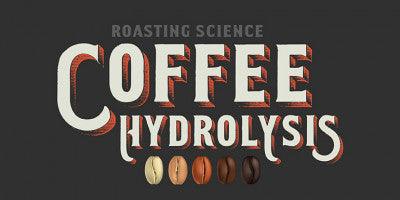
Low Acid Coffee Roasting: Part One Hydrolysis
Low Acid Coffee Roasting: Hydrolysis
Part 1: Hydrolysis
 Coffee is a thermally charged beverage. In its raw form, coffee beans exist as a store for various chemical compounds such as amino acids, proteins, polysaccharides, caffeine, and organic acids and compounds. It is through the process of roasting the coffee bean that we are able to access nearly 1,000 flavor compounds and aromas trapped in the coffee bean.
Coffee is a thermally charged beverage. In its raw form, coffee beans exist as a store for various chemical compounds such as amino acids, proteins, polysaccharides, caffeine, and organic acids and compounds. It is through the process of roasting the coffee bean that we are able to access nearly 1,000 flavor compounds and aromas trapped in the coffee bean.
This is accomplished through the controlled application of the heat through conductive and convective heat transfer for a predetermined duration. This controlled application of temperature and time during the roast process is called a roast profile.
To thermally charge coffee, heat is required to drive two transformative processes; Hydrolysis and Pyrolysis. In part one of this series, we will focus on Hydrolysis.
Hydrolysis describes the reduction and removal of the moisture in the coffee bean during the initial phase of the roast. This initial phase of the roast is called the drying phase.
When processed at origin, the raw coffee bean (green bean) is dried to a stabilizing moisture content of between 8% to 12%. To much or too little moisture content can impact the usable life of the coffee bean, its taste, and provide for growth of molds.
However, when roasting coffee the existence of moisture in the coffee bean will inhibit the chemical reactions that are necessary for the coffee bean to develop during the roast. The drying phase then becomes the first, and very critical step that paves the way for all other reactions during the coffee beans development.
During the “drying phase” of the roast, the heat is transferred to the coffee bean by means of conductive and convective heat transfer.
Hydrolysis by Conduction
Conductive heat transfer concentrates heat on the outside of the coffee bean through the coffee beans contact with the roaster drum as the beans are spun on the drum in the roasting chamber during the roast. The application of the heat to the coffee bean raises the bean temperature until the surface moisture of the coffee bean is turned to steam at 212F. Moisture near the surface of the bean is the first to be removed.
Hydrolysis by Convection
The convective heat transfer penetrates the coffee bean and begins the process of heating the core of the bean. As water inside the coffee bean turns to steam around 212F, pressure begins to build inside the coffee bean. Interestingly, as the pressure increases inside the core of the coffee bean, the steam pressure acts an inhibitor to further Hydrolysis, thereby requiring more heat to be added to the coffee bean in order to continue Hydrolysis. This entire process of Hydrolysis is endothermic in nature as considerable amount of heat is absorbed to charge the coffee bean.
Hydrolysis by Temperature:
In our process of slow roasting, we can observe Hydrolysis during the drying phase of the roast begin to transform and remove the moisture from the bean starting around 212F. However, because of the increased steam pressure inhibiting hydrolysis, considerably more heat must be added for several more minutes until the bean temperature reaches about 280F.
Hydrolysis Observed:
As the moisture in the coffee bean is either removed or converted to steam. The coffee bean will begin to change color. The green color, which is the color of the raw coffee bean, will begin to lighten as the moisture and chlorophyll are removed during Hydrolysis.
The aroma will change from the musty green bean coffee smell to an aroma of “wet grass” you might associate with a Saturday morning mowing your lawn.
It is at this very brief point, that the coffee beans momentarily turn a white color. With the moisture removed or turned to the steam, the water can no longer inhibit the chemical reactions and the second phase of the roast will begin. The water pressure that once inhibited Hydrolysis will now assist in the chemical changes within the coffee bean as the Maillard reaction begins and second phase of the roast commences.
Hydrolysis then is a key to roasting coffee. Without Hydrolysis, the many flavor compounds in the roast would be inhibited from reacting and the pressure, which will play a key factor in the roast during the second phase, would be limited.
To roast coffee then, a coffee roaster will to design a coffee profile to have the desired ratio of conductive and convective heat and to start and complete hydrolysis during the roast. A skilled coffee roaster will design the profile to build pressure in a controlled manner to achieve his desired goals of when and how fast Hydrolysis takes place and when Pyrolysis begins. More about that in our 2 part of the series.
At the end of roast entire, only 0.5% of the initial moisture content will remain in the coffee bean.
- Mavericks